Translate this page into:
A Qualitative Study to Assess Collusion and Psychological Distress in Cancer Patients
Address for correspondence: Dr. Roshan Sutar, 76/11, 6th Cross, 6th Main, Official Quarters, Bairasandra, Jayangar 1st Block, Bengaluru - 560 011, Karnataka, India. E-mail: roshidoc@yahoo.co.in
This is an open access journal, and articles are distributed under the terms of the Creative Commons Attribution-NonCommercial-ShareAlike 4.0 License, which allows others to remix, tweak, and build upon the work non-commercially, as long as appropriate credit is given and the new creations are licensed under the identical terms.
This article was originally published by Wolters Kluwer - Medknow and was migrated to Scientific Scholar after the change of Publisher.
Abstract
Introduction:
Collusion is frequently encountered but least studied entity in palliative care services in India. Impact of collusion is manifold and identifying it requires good communication skills. Once identified, it gives an indication for existing healthy versus developing unhealthy collusion to be dealt within families.
Objective:
The objective of this study was to identify the prevalence of collusion and its clinical and psychological correlates among patients and caregivers in a palliative cancer care.
Materials and Methods:
We describe systematic identification and unraveling of collusion across multiple levels in a palliative cancer care eventually drafting an algorithm to unravel the collusion. Patients and families were recruited from in-patient palliative care services after obtaining written informed consent. Qualitative interviews were conducted using collusion questionnaire, EQ5D, Visual Analog Scale, and NIMHANS psychiatric morbidity screen.
Results:
Among 62 cancer families interviewed, we identified that 71% collusion exists between doctor and patient, 61.3% between doctor and caregiver, and 75.83% between patient and caregiver. Around 50% collusions were unraveled systematically. Collusion was more prevalent in patients with rapid progression of illness (<6 months), patients with poor coping skills, and preference of being interviewed alone.
Conclusion:
This statistics suggests that collusion goes unnoticed in terminal illnesses and communication skills play a major role in identifying and dealing with collusion. This also unearths need to formulate interview techniques and structured assessment tools or questionnaire in palliative cancer care which are sparse.
Keywords
Cancer
collusion
communication
palliative
INTRODUCTION
Palliative care is an important component of so-called “end of life care” and is especially important in terminal illnesses like cancer. Pain, fatigue, loss of dignity, depression, and stigma are few disabling aspects for cancer patients. They pose a significant impact on the quality of life of patients as well as their caregivers, collusion is one of them.[1] In simple words, collusion is defined as a secret agreement or cooperation between two or more people who are trying to deceive (Oxford Dictionary. 2nd ed.) In healthcare, collusion implies any information (about the diagnosis, prognosis, and medical details about the person who is ill) being withheld or not shared among individuals involved in care. Collusion also means that relevant and complete medical information is selectively or not disclosed at all to patients and/or relatives.[1] The purpose of this study is to find the prevalence of collusion among cancer patients admitted in a palliative cancer care and their clinical and psychological correlates by systematically asking them a series of questions using collusion questionnaire and address the unnecessary patterns of collusions to demystify and improve the quality of life of patients and caregivers. The aim of this study is to identify the existing communication gaps among patient and family members about diagnosis and prognosis of the cancer and assessing psychological distress associated with it. Earlier studies done in Indian and western setups have shown that collusion is quite prevalent in palliative care services.[2] It is possible that syndromal depression might be absent in terminally ill patients, but constant psychological distress would make them think pessimistically about self, environment, and future. Furthermore, grief about the continuous loss of health may change their perceived disability, spiritual well-being, and expectations from treating team which has been hardly studied in a single study so far. These components are important with respect to changing the quality of life as reported in a study.[3] It is also found that communication gap exists among treating team and patient about not revealing diagnosis or prognosis of an illness, and there is a paucity of standardized interview schedules for this unmet need.[4] This study also highlights a systematic algorithm to interview families involved in unnecessary collusion and to unravel it systematically.
An idea of cure to palliation involves multiple transitions at psychological levels where collusion acts as conspiracy of silence! Based on the individuals involved in direct care of the patient, it can be classified into doctor–patient collusion, doctor–caregiver collusion, patient–caregiver collusion, and doctor–healthcare professional collusion or combination of any of above. Based on the cultural context, collusion is divided into cultural collusion and familial collusion.[5]
Unraveling of unhealthy collusion helps family to focus on pragmatic issues altogether as honest and open communication is less likely to result in untoward consequences. It may help patient to fulfill his unfinished business, repair of relationships, and coming to terms with family and friends. Patients would not regret if false optimism is not maintained (Back AL, 2006). Psychosocial issues are too complicated to handle for untrained staff and having a liaison with psychiatrist encourages proactive dealing with the collusion.
MATERIALS AND METHODS
This is a qualitative cross-sectional study with mixed method design conducted at palliative care ward of Kidwai Memorial Institute of Oncology, Bengaluru, India. The study was conducted for 8 months from September 1, 2015 to April 30, 2016. Ethics committee approved the study and written informed consents were obtained from patients and caregivers. The study was divided into five parts as reflected in a flow chart [Figure 1].
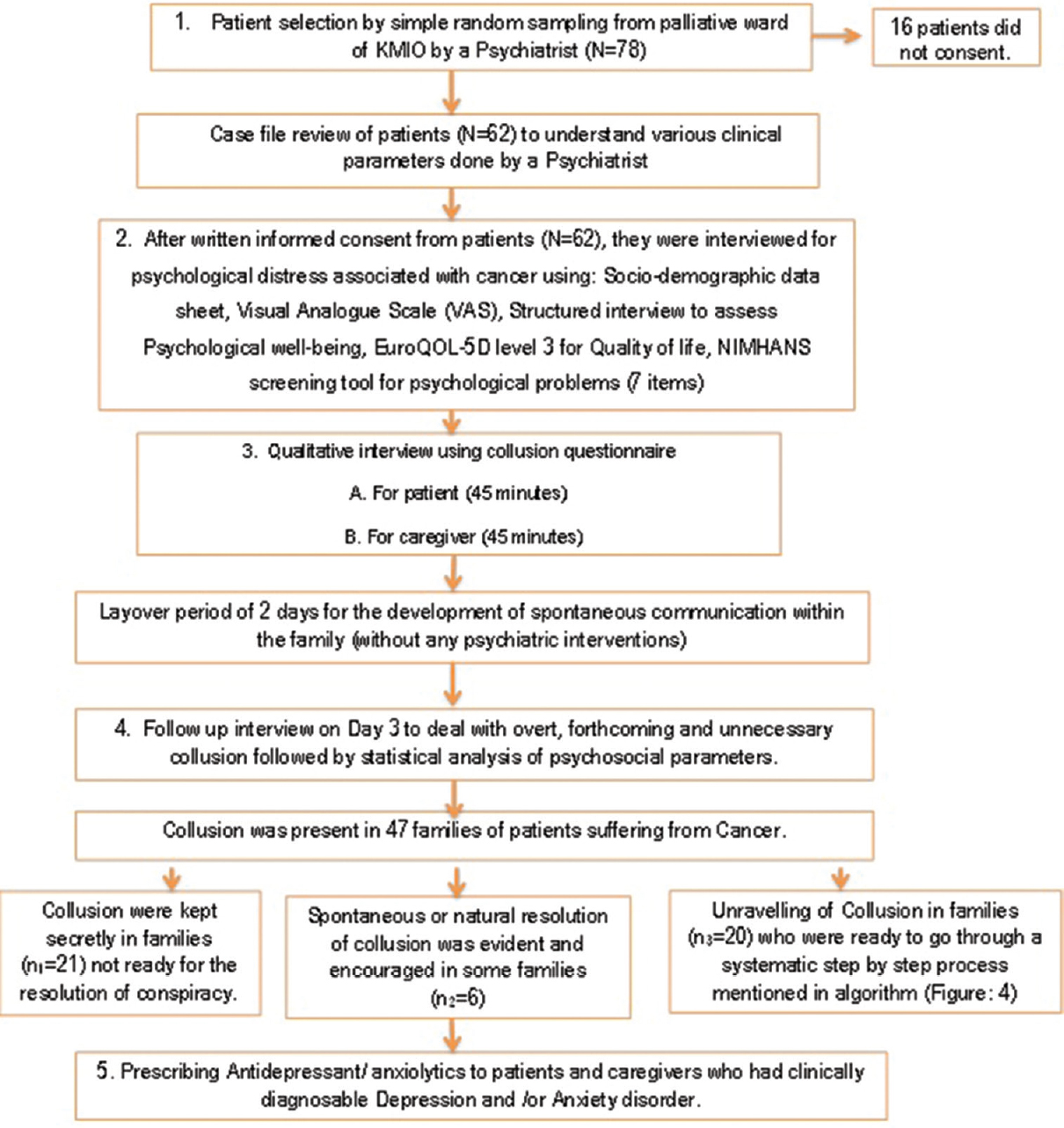
- Methodology flow chart
The first part was a case file review of admitted patient selected by simple random sampling allocating random numbers to 10 beds occupied by patients at palliative care ward. Two families were interviewed every week. Odd and even beds in series were chosen every alternate week. This included a detailed understanding of nature of cancer progression, tumor-node-metastasis (TNM) classification, ongoing chemotherapy/radiotherapy/surgery, need for palliation, current analgesic medications, etc., The second part included the assessment of psychological distress among patients which included sociodemographic data sheet, Visual Analog Scale,[6] structured interview to assess psychological well-being, EuroQOL-5D-level-3,[7] and NIMHANS psychiatric morbidity screen (seven items).[8] The interview to assess psychological well-being consisted of items such as distress related to the diagnosis of cancer and acceptance level (anger/acceptance), which was based on the study done earlier.[9] Explanatory model of patient acquiring cancer (denial/bargaining) distress related to adverse effect of medications, Beck's triad of depression, spiritual inclination, faith healing seeking/frequency, coping strategies, most disabling aspect of life – currently and longitudinally, perceived support from spouse/children/parents/other primary caregivers, and expectation from medical professionals (cure/euthanasia). The interview questions were systematically structured by a panel consisting of two psychiatrists and two palliative care specialists. In the third part, qualitative interviews were conducted to identify existing collusion with patient and caregivers together and using collusion questionnaire. It is a 14-item questionnaire to be used in sequential manner where response to previous questions is taken into account for the next question in the series [Figures 2 and 3]. The interview using collusion questionnaire takes approximately 45 min for one interviewee, followed by which a buffer period of 2 days was offered considering high possibility of developing spontaneous communication within family to unravel the collusion naturally. In the fourth part, follow-up interviews with patient and caregiver were carried out on day 3 to watch out for prognosis of collusion. Those families where collusion appeared to start unraveling were encouraged further by a psychiatrist [Figure 4]. The fifth part was prescribing antidepressants and anxiolytics to patients and family members who met the clinical diagnosis (very few patients required it; hence, log of which has not been kept). Patients and caregivers who required medications for the diagnosable depression and anxiety disorders were treated accordingly.
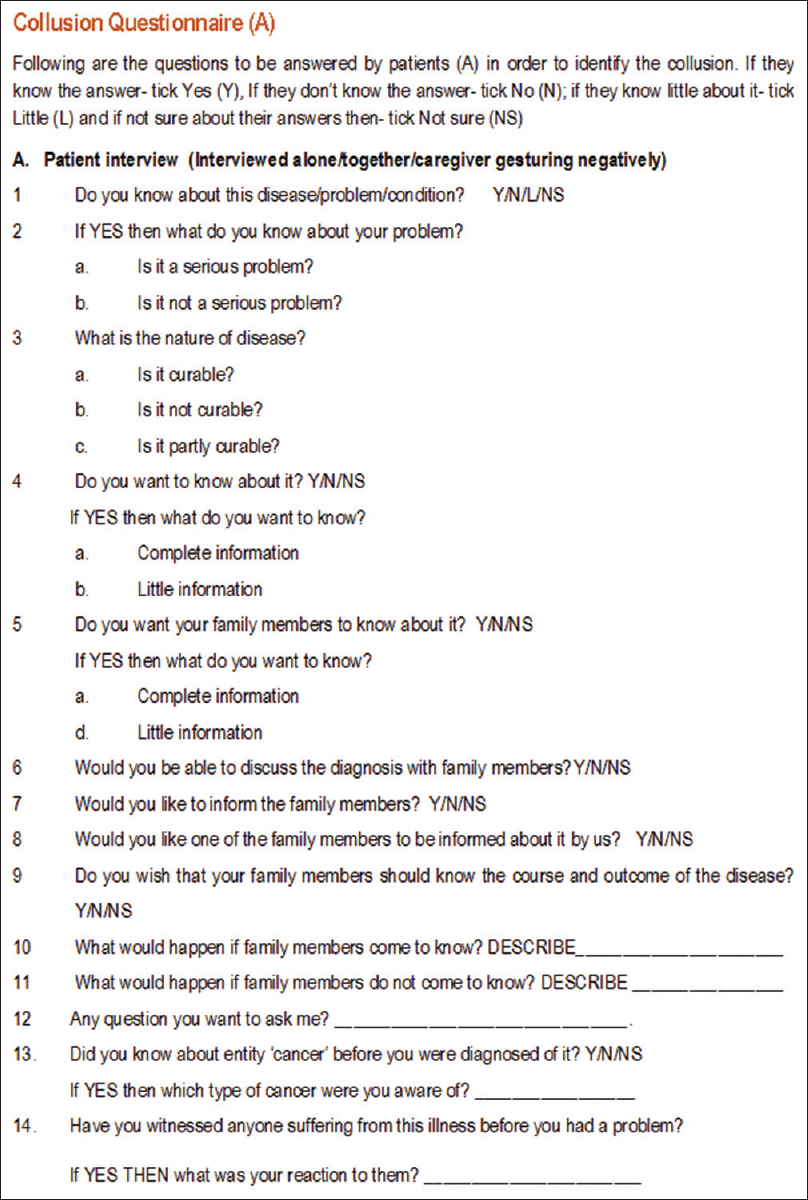
- Collusion questionnaire for patients
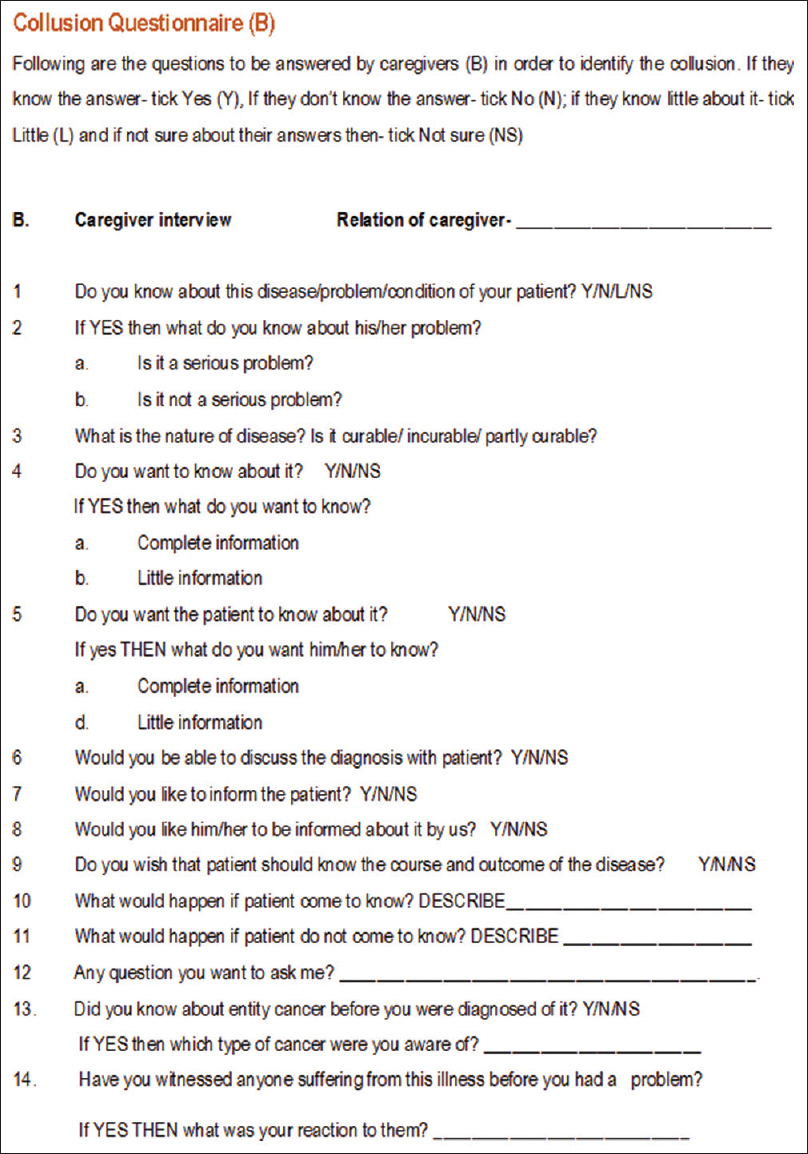
- Collusion questionnaire for caregivers
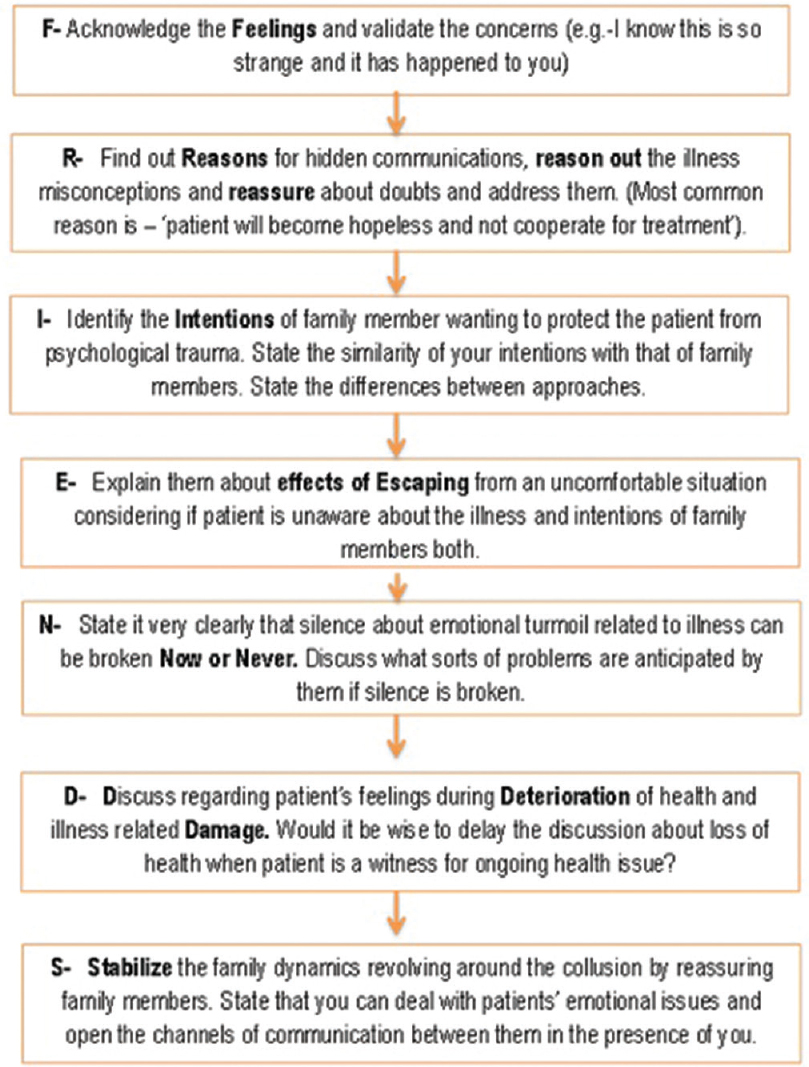
- Algorithm for dealing with an existing collusion
Sample size
Since this study was based on systematic qualitative interviews, saturation to responses was a criterion for determining the sample size. Saturation for selected four items of collusion questionnaire reached at the 60th interview. Considering logistics of the duration of the study in such clinical setting, initially, the sample size was calculated to be 64 based on the following statistics: interviewing two families per week over a span of 32 weeks' (8 months) duration and considering a follow-up interview within 3 days of first interview, the total number of expected families to be interviewed was approximately 64. The final sample size at the end of the study was 62.
Statistics
Frequency distributions of demographic, clinical, and psychological variables were carried out. The Chi-square test was used to determine the goodness of fit with confidence interval of 95% and standard error of 0.05. Binary logistic regression was used to find the correlation of collusion with different parameters using Statistical Package for the Social Sciences (SPSS) version 20 for statistical analysis (IBM SPSS Inc., Armonk, New York 2016).[10]
RESULTS
A total of 62 patients admitted to palliative section of cancer hospital were interviewed for identifying collusion. The mean age of the sample was 50 years (standard deviation = 12.36). It was found that around 60% of them were male and 79% of the patients were married. Eighty-five percentages of patients were belonging to the Hindu religion. Overall, majority of patients were illiterate (75.8%) as compared to professional qualification (6.5%) [Table 1].
| Frequency (%) | |
|---|---|
| Gender | |
| Male | 25 (40.3) |
| Female | 37 (59.7) |
| Marital status | |
| Married | 49 (79) |
| Separated | 5 (8.1) |
| Widowed | 8 (12.9) |
| Religion | |
| Hindu | 53 (85.5) |
| Muslim | 8 (12.9) |
| Others | 1 (1.6) |
| Education | |
| Illiterate | 47 (75.8) |
| Primary | 3 (4.8) |
| Secondary | 8 (12.9) |
| Professional | 4 (6.5) |
| Occupation | |
| Unskilled | 56 (90.3) |
| Semiskilled | 5 (8.1) |
| Skilled | 1 (1.6) |
Major systems involved in cancer were gastrointestinal, reproductive, and orofacial. Majority of them were TNM Stages 2 or 3 which is why patients required treatment under palliative care services. Eighty-two percentages of patients were already on oral morphine solution for pain control while 66% were undergoing chemotherapy, 50% radiotherapy, and 43.5% underwent recent surgery [Table 2]. However, the systematic records of treatment were not documented in terms of first symptom and first treatment after the diagnosis of cancer as these were not the objectives of the study. Vomiting (27.4%) was the most common adverse effect found among patients with palliative needs which may be due to the adverse effect of chemoradiotherapy and opioids; interestingly, 64.5% were free of any adverse effects [Table 2].
| Frequency (%) | |
|---|---|
| Cancer affected system | |
| Gastrointestinal and hepatobiliary | 16 (25.8) |
| Reproductive | 14 (22.6) |
| Orofacial | 13 (21) |
| Blood cells | 5 (8.1) |
| Breast | 5 (8.1) |
| Respiratory | 4 (6.5) |
| Other system involvement | 5 (8.1) |
| TNM stages of cancer | |
| 2 | 27 (43.5) |
| 3 | 28 (45.2) |
| 4 | 7 (11.3) |
| Treatment given to the patients | |
| Chemotherapy | 41 (66.1) |
| Radiotherapy | 31 (50) |
| Surgery | 27 (43.5) |
| Oral morphine solution for pain control | 51 (82.3) |
| Adverse effect of treatment | |
| Nil | 40 (64.5) |
| Vomiting | 17 (27.4) |
| Lymphedema | 5 (8.1) |
TNM: Tumor node metastasis
Regarding psychological needs of patients, it was found that 56% had healthy acceptance of the illness as per Kubler-Ross stages of assessment of grief. There was a significant correlation of development of collusion with poor coping skills, high psychological distress, and rapid progression of illness, that is, shorter duration of illness [Tables 3 and 4]. Thirty-seven percentages of patients attributed the illness to God following attributions to karma (16%), medical reasons (27%), and personalized model of illness (19.4%) as explained through few examples in Table 5. Surprisingly, only 1.6% of patients were found to have unhealthy coping associated with illness and its progression, and only 14.5% of patients reported to have pessimistic view of self, environment, and future while 85% did not. Nearly 67% of patients had clear understanding that illness has nothing to do with faith healing or other forms of treatments while it was found that patients' inclination toward spirituality was very high (>70%) as compared to absent spiritual support (3.2%)
| Frequency (%) | |
|---|---|
| Kubler-Ross stages of coping | |
| Acceptance | 35 (56.5) |
| Anger | 8 (12.9) |
| Bargaining | 11 (17.7) |
| Denial | 8 (12.9) |
| Explanatory model of patient in acquiring the illness | |
| Attribution to God | 23 (37.1) |
| Attribution to Karma | 10 (16.1) |
| Medical reasons | 17 (27.4) |
| Personalized model | 12 (19.4) |
| Coping with the illness | |
| Poor | 1 (1.6) |
| Not so bad | 14 (22.6) |
| Good | 26 (41.9) |
| Excellent | 21 (33.9) |
| Beck's triad of depression | |
| Yes | 9 (14.5) |
| No | 53 (85.5) |
| Spiritual inclination | |
| Absent | 2 (3.2) |
| Mild to moderate | 15 (24.2) |
| Moderate to high | 29 (46.8) |
| High | 16 (25.8) |
| Faith healing/magico-religious treatment seeking tendencies |
|
| Absent | 18 (29) |
| Low | 24 (38.7) |
| Medium | 13 (21) |
| High | 7 (11.3) |
| Disabling aspect of life at present situation | |
| Pain | 46 (74.2) |
| Dysphagia | 4 (6.5) |
| Weakness | 3 (4.8) |
| Bleeding | 2 (3.2) |
| Dyspnea | 2 (3.2) |
| Disfigurement | 1 (1.6) |
| Dysarthria | 1 (1.6) |
| Stigma | 2 (3.2) |
| Micturition frequency | 1 (1.6) |
| Perceived support | |
| Spouse | 24 (38.7) |
| Children | 12 (19.4) |
| Both | 19 (30.6) |
| Others | 7 (12.3) |
| Expectation from health professionals | |
| Cure | 35 (56.5) |
| Palliation | 20 (32.3) |
| Death/euthanasia | 5 (8.1) |
| Others | 2 (3.2) |
| Disabling aspect of life in future | |
| Family worries | 23 (37.1) |
| Pain | 17 (27.4) |
| Work/job | 12 (19.4) |
| Basic needs | 2 (3.2) |
| Weakness | 1 (1.6) |
| Illness | 1 (1.6) |
| Nil | 6 (9.7) |
| Variable | SE | P | CI | |
|---|---|---|---|---|
| Lower limit | Upper limit | |||
| Duration <6 months | 0.742 | 0.008 | 0.033 | 0.598 |
| High level of psychological distress | 0.814 | 0.014 | 0.027 | 0.667 |
| Preference for interviewing alone by patient | 0.753 | <0.001 | 0.012 | 0.224 |
| Readiness of patient to discuss with family members | 1.136 | 0.004 | 3.296 | 9.534 |
| Readiness of patient to inform details of illness | 1.120 | 0.002 | 3.626 | 29.126 |
SE: Standard error, CI: Confidence interval
| 1. A 70-year-old Muslim gentleman was angry toward his wife when admitted to cancer hospital after shifting from the general hospital where diagnosis revealed high-grade squamous cell carcinoma of the lung with pleural effusion. The patient denied that he had any illness ever, instead persecuted his first wife and a sister for doing black magic on him and giving him such pains |
| 2. A 55-year-old Hindu gentleman after diagnosing secondary metastasis at the lower end of humerus underwent resection of bone metastasis, followed by abdominal pain. In that intense agony, he had not forgotten to curse his previous surgeon who operated on bone metastasis. Somehow, he was sure that doctor had done something wrong with him which is causing abdominal pain now. He investigated across multiple hospitals and finally visited the one where we were seeing him. He broke down when spoke about eight multispecialty hospital journey still being unaware of his diagnosis and still hoping to get discharged soon and visit another multispecialty hospital. This gentleman was counseled and relieved over next 1 week |
| 3. A 50-year-old truck driver presented with recurrence of multiple myeloma after 5 years. While crying he stops and talk about symbolic cure connected 5 years back when a specific honey bee sting coincided with his admission in hospital for an intense agonizing pain in back and was found to have bone metastasis at L5S1. He recovered through chemoradiotherapy and surgery. This time, the symbolic help and symbolic cure can only be brought back through symbolic repeated honey bee stings and current admission to cancer hospital for relapse of myeloma. He denied that he has any serious illness |
The most disabling aspect of cancer was pain according to 74% of patients, followed by dysphagia, dyspnea, and disfigurement. The most common perceived support for a cancer patient was his or her spouse (38.7%), followed by children (19.4%) and others (12.3%). The most common expectation of a cancer patient from his treating physician was cure (56%), followed by palliation (32.3%) and death or passive euthanasia (8.1%). When they were asked about their future concerns, the most common response was family-related worries (37.1%), followed by pain relief (27.4%) and occupation-related issues [Table 3]. Around 10% of patients did not report any specific concerns about their future. Summary of interview preferences and common responses from patients and their caregivers about readiness to unravel the collusion are described in respective tables [Tables 6, 7a, 7b, 8a and 8b].
| Interview preference given by the patient | Frequency (%) |
|---|---|
| Alone | 42 (67.7) |
| In presence of caregiver | 13 (21) |
| In presence of caregiver but negative | 7 (11.3) |
| gesturing by relatives |
| Caregiver's response | What would happen if patient come to know about the condition |
|---|---|
| 1 | Will break down |
| 2 | Will be sad and depressed |
| 3 | Will not cooperate for treatment |
| 4 | Will ask to take treatment from other hospitals |
| 5 | Will think of dying |
| 6 | Will stop taking food and water |
| 7 | Will ask for discharge immediately |
| 8 | Will be angry and scold us |
| 9 | Will be afraid of touching us and sharing food |
| 10 | Will make his illness progression fast due to tension |
| Caregiver's response | What would happen if the patient do not come to know about the condition |
|---|---|
| 1 | Will have good quality of life |
| 2 | Will be able to live longer |
| 3 | I do not know |
| 4 | Will stay happy |
| 5 | Will continue to accept the treatment |
| 6 | Will continue to worry about what is happening with his/her health |
| 7 | Will stop using tobacco at least |
| 8 | You tell me doctor, what to do? |
| Patient's response | What would happen if family members come to know about the condition |
|---|---|
| 1 | Will be upset and sad |
| 2 | Will become emotional and cry |
| 3 | Will be burdened by the fact that I cannot support them anymore |
| 4 | Will be in terrible condition and fearful |
| 5 | Will worsen their health conditions |
| Patient's response | What would happen if family members do not come to know about the condition |
|---|---|
| 1 | They will never believe that I have cancer |
| 2 | They probably know partially/completely about my cancer |
| 3 | They will take care of me |
In terms of interviewing patient on collusion questionnaire when preference was asked, 67.7% preferred to talk alone with therapist while 32% preferred with relatives, out of which 11.3% were supported by relatives through answering certain uncomfortable questions and gesturing to physician to not disclose certain issues in front of patients as depicted in Figure 5. This was statistically significant with existence of collusion in a family [Table 4]. Some of the common responses used in response to collusion questionnaire by patient as well as caregivers are presented in Figure 6. Around 82.3% of the patients and 48.4% of caregivers reported that they did not know about entity cancer before they reached current hospital. There was a significant correlation of patient's unwillingness to discuss with relatives and existence of collusion in a family [Table 4].
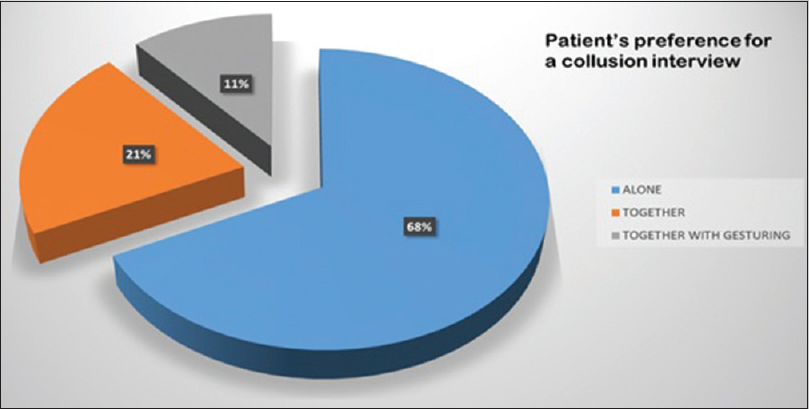
- Interview preference by patients
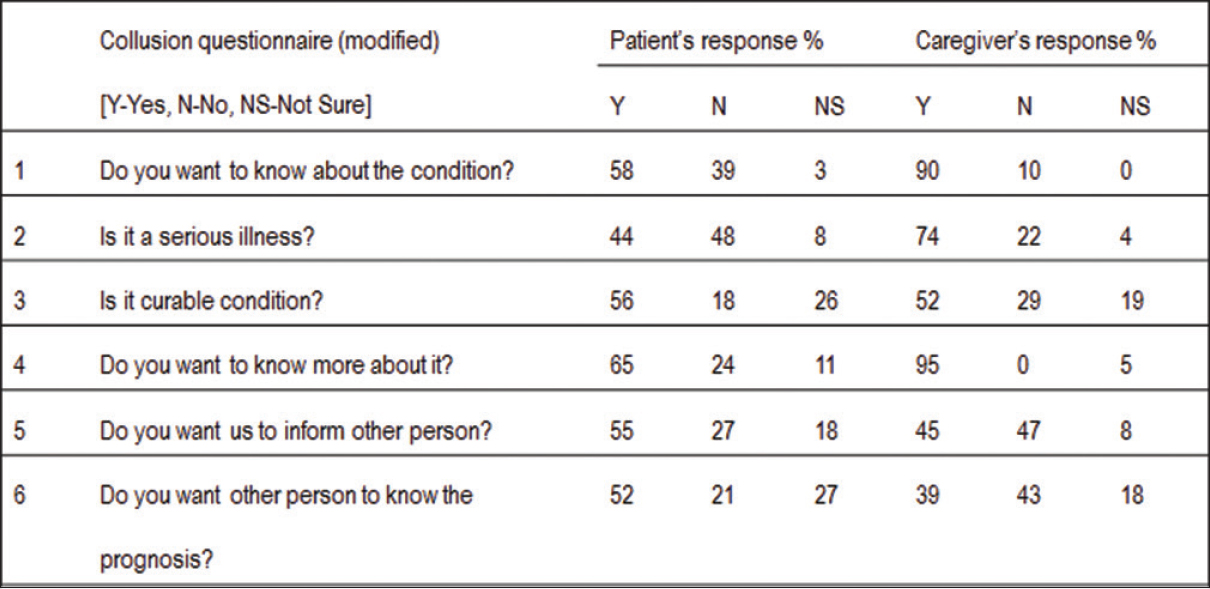
- Common responses to collusion questionnaire
It was found that unwillingness to communicate about the illness was highly prevalent among all three groups with figure of 71% between doctor and patient and 61.3% between doctor and caregivers while 75.83% between patient and caregiver depicted in Figure 7. With work that was carried out intended to support family in terms of their psychological needs and to improve the quality of life, almost 41.9% of doctor–patient and doctor–caregiver collusions were unraveled while 33.9% were left untouched as shown in Figure 8.

- Percentage of collusion between three groups
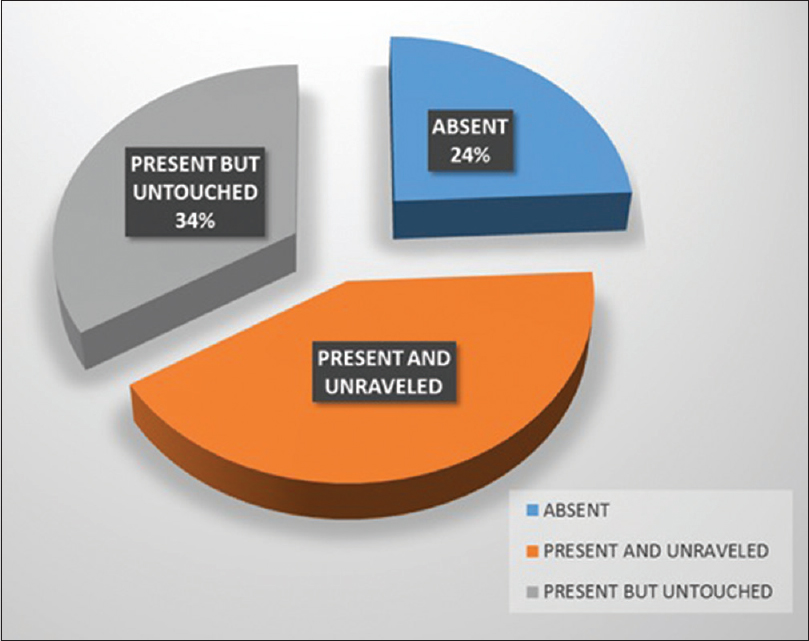
- Percentage of collusions unraveled
DISCUSSION
Cancer is a multifactorial disease, and its management is multidimensional which involves chemotherapy, radiotherapy, surgery, and palliation. In patient's understanding, this is a very complex management and communicating various aspects of cancer, and its treatment can help substantially to halt the collusion development. More than 75% of the patients interviewed in the study were illiterate and involved in unskilled occupation. This may be due to a reason that study was conducted in a tertiary care government institute which provides subsidized rates of treatment for poor patients and also being one of the largest cancer care hospitals with palliative care services in the region. Hence, it is highly recommended to impart them basic understanding of various illness parameters. Hindu, married and male patients were overrepresented in this study due to methodological limitations. It is possible as Hindu community is predominant population of the region, may be more open to medical model of illness than others. The substance use has been associated with an increased incidence of cancer.[11] In the current study, around 66% of the patients had exposure to tobacco and alcohol before the development of cancer. Collusion is very common in palliative cancer care services (76%) in current clinical observation.[12] Stepwise communication toward patient and caregiver can break unhealthy collusion (42% in the current presentation).[13] Collusion can interfere with treatment seeking, compliance, and interpersonal family dynamics. Handling collusion effectively may help to improve the overall quality of life. More than 50% of families attributed illness to supernatural powers such as “God” and “Karma” possibly a result of culturally acceptable definitions of sufferings while attribution to medical reasons indicates high level of understanding about illness through witnessing such patients or watching advertisements in media. Personalized models of an illnesses stems from denial about the illness since most of them reflect curable etiological models as explained earlier in Table 5.[1] Collusion was highly correlated with high psychological distress and poor coping skills among patients which might explain the caregiver's goodwill to protect them by not revealing the truth in some cases. The study findings also reflect that clinical depression is less common than psychological distress and anxiety among patients involved in palliative care.[14] Despite which more than half of the patients and family members were aware that they had a serious illness and it has no cure but did not discuss about it with family members which indicates that it is worthwhile to talk about “end of life issues,” dying process and unfinished works with them rather that keeping it a secret. The most common disabling aspect in terminal cancer is pain[15] that was consistent finding with this study. However, prospectively, family worries were more disabling for patient and pain ranked second in the list. Around 68% of patients preferred to be interviewed in the absence of caregiver, and this factor was statistically significant with existence of collusion in family. This clearly open up the discussion whether we as a clinician are not adequately equipped with communication skills and further it brings up a question that quality of life of patient and family could have been better if communication gap between family and patient is effectively reduced by dealing with collusion though no statistical correlation was found between collusion and quality of life in this study. Figure 4 reflects the workflow to unravel the collusion systematically. To identify and deal with the collusion is a challenging task,[16] which requires systematic approach to screen and develop innovative psychological intervention to improve the service delivery in palliative care.[13] We need to deliver the message that even the worst disorders have the potential for an unexpected outcome. In serious illnesses such as cancer, providing numbers is like a death sentence (e.g., median survival time). It is better to not give false optimism and screen for psychological distress more than syndromal diagnosis.[5] Each clinician can formulate words and phrases that capture paradox of uncertainty to sustain hope and honesty which might require certain level of communication skills in breaking bad news and dealing with collusion. After all, unraveling of the collusion can also help us to divert focus from body to soul and fits well in definition of healing in the Indian context.[1] Reading patient's needs at particular stage of serious illnesses is a key to deal with treatment refusal and treating noncompliance. Sometimes, narrative catharsis helps for self-healing as we are aware that medical uncertainties are certain!
Financial support and sponsorship
Nil.
Conflicts of interest
There are no conflicts of interest.
Acknowledgment
The author would like to acknowledge Mr. Shivakumar, a cancer survivor and an inspiring source of energy for this research. We also thank to Dr. Ayesha and Dr. Mala from Kidwai hospital, Bangalore and Dr. Nagesh Simha from Karunashraya hospice, Bangalore for their encouragement.
REFERENCES
- Communication with relatives and collusion in palliative care: A crosscultural perspective. Indian J Palliat Care. 2009;15:29.
- [Google Scholar]
- Benefit or harm. A study on impact of collusion on the quality of life among palliative care patients? Indian J Palliat Care. 2018;24:61-6.
- [Google Scholar]
- Does awareness of diagnosis make any difference to quality of life. Determinants of emotional functioning in a group of cancer patients in Turkey? Support Care Cancer. 2002;10:51-7.
- [Google Scholar]
- Talking with terminally ill patients and their caregivers about death, dying, and bereavement: Is it stressful? Is it helpful? Arch Intern Med. 2004;164:1999-2004.
- [Google Scholar]
- The patient who 'must not be told': Demographic factors associated with collusion in a retrospective study in South India. Postgrad Med J. 2016;92:659-62.
- [Google Scholar]
- The validation of visual analogue scales as ratio scale measures for chronic and experimental pain. Pain. 1983;17:45-56.
- [Google Scholar]
- Real-world EQ5D health utility scores for patients with metastatic lung cancer by molecular alteration and response to therapy. Clin Lung Cancer. 2017;18:388-95.e4.
- [Google Scholar]
- Development and validation of NIMHANS screening tool for psychological problems in Indian context. Asian J Psychiatr. 2014;10:33-8.
- [Google Scholar]
- Coping well with advanced cancer: A serial qualitative interview study with patients and family carers. PLoS One. 2017;12:e0169071.
- [Google Scholar]
- IBM SPSS Inc. SPSS Statistics for Windows. In: IBM Corp. Armonk, New York: IBM SPSS Inc; 2012.
- [Google Scholar]
- Adjustment for tobacco smoking and alcohol consumption by simultaneous analysis of several types of cancer? Cancer Causes Control. 2017;28:155-165. doi:10.1007/s10552-016-0847-x
- [Google Scholar]
- Collusions between patients and clinicians in end-of-life care: Why clarity matters. J Pain Symptom Manage. 2017;53:776-82.
- [Google Scholar]
- Approaching difficult communication tasks in oncology. CA Cancer J Clin. 2005;55:164-77.
- [Google Scholar]
- Perceived distress and its association with depression and anxiety in breast cancer patients. PLoS One. 2017;12:e0172975.
- [Google Scholar]
- Early integration of palliative and supportive care in the cancer continuum: Challenges and opportunities? Am Soc Clin Oncol Educ Book 2013:144-50. doi: 10.1200/EdBook_AM.2013.33.144
- [Google Scholar]






